By Jeffrey A. Rendall, Photos by Scot Rendall
WINDSOR, CO – “If the golf is in the player’s hands, and they are making their own decisions on how to approach each golf hole with a range of options available to them, the experience will be more enjoyable, more engaging, more rewarding and less frustrating,” said Art Schaupeter, Course Designer at Highland Meadows Golf Course in northern Colorado.
I’ve heard a lot of architects’ explanations on how they see their golf designs, but I’ll have to admit, Schaupeter’s is one of the best. We’ve all been to too many courses where we’re forced to play in box – and we don’t like it.
Schaupeter continues, “Narrow or one-dimensional golf courses dictate that golfers hit specific shots at specific times. This can get frustrating to the majority of golfers who don’t have on-demand command of their game and this will create a frustrating experience.”
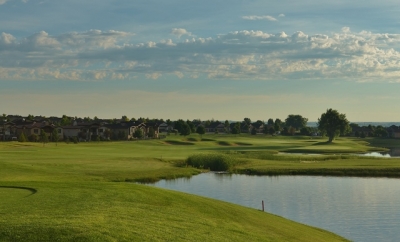 |
| From the very first tee shot of the day, you will have plenty of options at Highland Meadows. |
“My goal with my design philosophy and design style is to keep the golf challenging but to make sure the golf is in the player’s hands. They’ll enjoy it much more and they’ll be challenged in an encouraging way, not a beat down way.”
Such is the case at Highland Meadows, which is set on a fairly flat piece of land about an hour north of Denver.
Think of Colorado and you’re probably picturing rocky bluffs, mountain peaks and lush forest – but you have to remember there are some pretty level parts of the state, too.
Schaupeter describes the land when he first saw it. “The overall property had nice movement to it, but it was very ‘simple.’ The entire property was being farmed so there were no trees on site except for the one you see on the first hole. The grades were long and subtle, not a lot of highly interesting contours, but there was enough vertical elevation change to create some interesting and varied holes.”
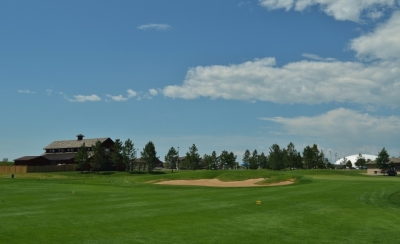 |
| It is hard to tell from this view, but the 18th green is quite a challenge. |
And because it was to be a “neighborhood course” (as the owner put it), there was a large grading operation to establish lot grades around the site. Schaupeter was then left to do what he wanted between the lot lines to grade the golf holes as he saw necessary.
Schaupeter said the exception to the “simplicity” of the site was a 30’ deep arroyo that ran along the eastern edge of the land and spurred up into the property (today as part of holes 6-7 and 13-17). This feature presented an opportunity to create some very unique and dramatic golf holes while utilizing the only really interesting feature on the property.
The overall golf course routing took shape from these holes. The rest of the holes in the property interior were located based on making the whole development work efficiently.
“To the owner’s credit, he let me put as much golf as I could fit along the arroyos,” Schaupeter remembered. “This created the most dynamic golf, but it also limited the amount of housing frontage he would have directly on the golf holes.”
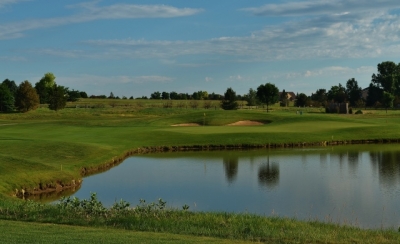 |
| The beautiful 4th hole is the shortest par three on the course. |
“It seems to have worked out well as the development is doing great and the golf course has been successful and well-received from the beginning with the golfers’ not being subjected to eighteen holes of houses on both sides of each hole.”
Community golf is the norm these days, so we’re all used to playing down housing corridors. But thanks to the aforementioned arroyo, there is a certain openness to Highland Meadows that you wouldn’t always encounter in a development course.
For his part, Schaupeter did a great job in supplying that “open” feeling. He lived in Colorado for a little over a decade (went to high school there and attended The University of Colorado at Boulder), so it was like a homecoming for him to work at Highland Meadows.
Schaupeter got his start in golf design by working for architect Keith Foster, who himself studied under another master designer, Arthur Hills. It was under Foster’s direction that Schaupeter assisted on two Colorado courses -- Buffalo Run in Commerce City and Haymaker in Steamboat Springs.
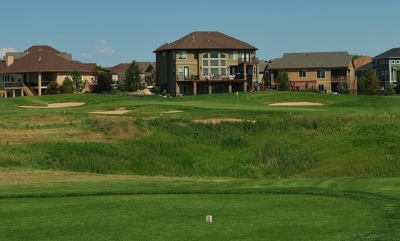 |
| The carry looks intimidating on the par three 16th hole, but there is plenty of room once you fly the trouble. |
Highland Meadows’ owner appreciated Schaupeter’s contribution to Buffalo Run and decided to give the newly solo architect a chance in Windsor, since the properties were similar.
“Foster was very adamant about studying the history of the sport and the history of design and so I have spent most of my career really focused on looking at golf design from a historical perspective, which means a Scottish/Irish perspective…how the attributes of links golf can be applied successfully on each project,” Schaupeter said.
You’ll definitely see those “old country” elements at Highland Meadows in the rolling nature of the terrain, broad swaths of fescue and creativity employed around the greens. For a course basically raised from a featureless farm field, there’s a significant amount of variation to the topography.
Combine Schaupeter’s experience with the “local knowledge” from having lived in the state and you’ve got a winning formula. He said Colorado’s high altitude provided the biggest challenge in designing the course.
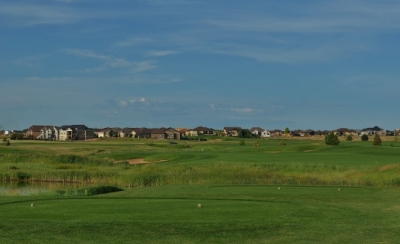 |
| The challenging dogleg left par four 6th is the number one handicap hole at Highland Meadows. |
“The golf course is right at 5000 feet elevation and that means better players are hitting the ball an additional 7-12% further depending upon club, wind, slopes, etc. For a guy hitting it 280 off the tee at sea level, he is now hitting it 300-315 yards,” he explained.
“I’d say it’s at least a club difference with your irons, too. It takes a bit of mental work to re-calibrate hazards and doglegs and general strategic considerations. Then I have to apply it to the full range of golfers in terms of skill levels, men and women, etc. I think that is the biggest challenge.”
“Otherwise, I love working in Colorado. The nice thing about the Colorado environment is the dry climate. That helps keep turf diseases down, allows the courses to be maintained drier and firmer, and is just generally more pleasant to play in,” he concluded.
The course was in outstanding condition when we played in early July. The area had actually been deluged by rain in a very wet spring, so everything was green and lush – but we can imagine Highland Meadows playing quite a bit differently in drier circumstances.
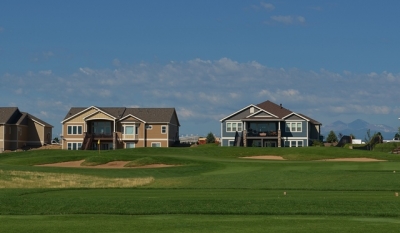 |
| The par three 11th hole aligns nicely with Longs Peak in the background. |
And as Schaupeter alluded to, the layout is basically divided between the more topsy-turvy holes near the arroyo and those set on flatter ground in the main part of the property. With some 70 bunkers on the course and Shaupeter’s creative mounding – some of the holes appear quite intimidating.
But the course’s width and bailout options make it play somewhat easier.
Schaupeter was surprised to hear we thought the course was intimidating visually but played easier. He thinks it’s the other way around.
“While there are some intimidating shots, especially among the stretch of holes that play along the arroyos, I would describe the course as looking easier and playing harder, maybe just slightly harder in this case, and that would be closer to my objective.”
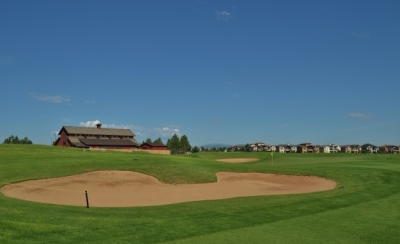 |
| Near the green of the long par four 9th hole. |
“I know a lot of golf courses get described as ‘looking harder but playing easier.’ I don’t think that makes for the best golf course. It sounds good, and correct, when you are trying to appeal to ‘average’ golfers, which is most of them, but to me that sounds like a course with potentially all looks and minimal or no substance,” he added.
As I mentioned, Highland Meadows has plenty of substance and perhaps I was a bit jaded by the carries over the arroyo – but again, the wide playing areas mitigated the difficulty and the green complexes provided the bulk of the challenge.
“Excessive and overly penal hazards (out of play, water, out of bounds) are not the right way to provide the ‘bite’ in a course. It must be subtle, varied green contours, varied green surround contours, multiple angles of approach to the greens, different ground contours and angles, offset hazards and minimal hazards,” Schaupeter elaborated.
The greens are large, which also makes them look “easy” in approach but challenging in practice. Three-putts are lurking if you’re on the wrong part of the green at Highland Meadows.
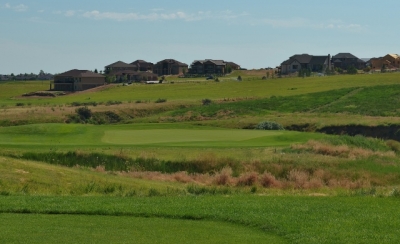 |
| It is a long carry to the green of the par three 13th hole, but there is plenty of room to bail left if you chicken out. |
One last note before describing a few of the highlight holes, don’t go to Highland Meadows expecting beautiful mountain views. Colorado may be “Rocky Mountain High,” but those mountains are quite a ways in the distance. You can see them for sure, but they’re not a big part of the experience.
Schaupeter expounds. “The entire site slopes to the east towards the arroyos I mentioned previously. We are also just too far away to put much emphasis on the mountain views. I did manage to get the eleventh hole, the par 3, oriented so that the view from the tee to the green has Long’s Peak directly in the background.”
“I am not sure if the future houses behind that hole will block the view or not, but that is about the only hole that I remember putting any thought into the mountain views. The site just wasn’t conducive.”
A links course with tall mountains wouldn’t look right anyway, right?
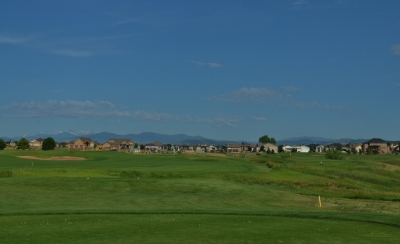 |
| The architect dares you to go for it on the potentially drivable par four 7th hole. |
Zachary Leeman, Highland Meadows’ Director of Golf Operations and Tournaments, agrees with Schaupeter that the property’s arroyo makes it special.
“Most of the arroyo is Environmentally Sensitive Area, and golfers are not permitted to enter those areas to retrieve balls or attempt strokes from them."
"The ESA and arroyo are home to native plant species, nesting meadowlarks, red-winged blackbirds, and our most vocal of wildlife residents, coyotes.”
Coyotes? Hope the local pets are kept indoors.
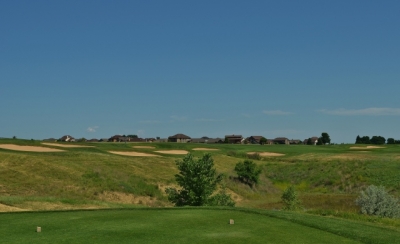 |
| The short par five 15th hole can play as easy or difficult as you dare. |
He continues, “The prevailing north winds that blow in from Wyoming can be a test to players as well, often dubbed ‘High-wind Meadows’ in the spring months, players better have their wind game in shape, and plenty of low-stingers off the tee.”
We wouldn’t know. The day we played was pleasant with dead calm wind. But as hinted at above, we appreciated the course’s difficulty anyway.
Leeman says the hole highlights start with the par five first hole. “Number one is a challenging par five that typically plays into a headwind. It’s a great risk/reward hole with water down the entire right side.
“Number six is our ‘signature hole’ and the number one handicap, a forced carry on the tee shot and on the approach shot. It’s visually daunting, and demands two solid golf shots to get your par."
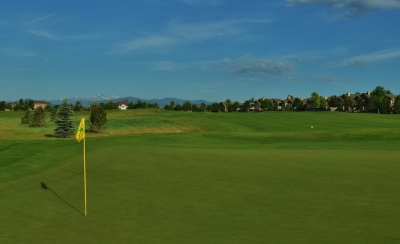 |
| Looking back from the green of the long par four 3rd hole, you will notice the mountains in the distance. |
“On the back, number thirteen is the only hole without a bunker. It’s a 243 yard par three from the back tees… this hole also will typically play into a head wind, and many players will bail out left and happily take their bogey and move on.”
I would add the 371-yard closing hole, which requires a carry over a pond and marsh to a portion of fairway that presents the best angle to the green. There is a wide bailout area to the left, which gives you options off the tee. As Schaupeter would put it, you’ve got the “golf in your hands.”
Highland Meadows is very walkable and Leeman says he encourages people to hoof it when the weather is right.
The course is open year-round, so if there isn’t any snow on the ground, tee it up in the winter as well!
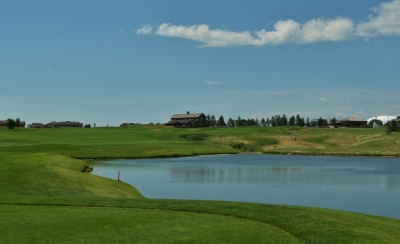 |
| Long hitters can easily fly the pond and marsh off the tee of the par four closing hole. For the rest, plenty of room to bail left. |
We’ll leave Leeman with the last word. “When players leave our course after playing 18 holes, I want them to take away an A+ experience from start to finish. We want those players to call here first when considering a course to play on the weekend. I want them to tell friends and family that their golf experience here far exceeded their expectations and they are looking forward to returning soon.”
With the golf in your hands, how could you ask for anything more?
Details:
6300 Highland Meadows Parkway
Windsor, CO 80550
Phone: 970.204.4653
Fax: 970.203.1450
Website: http://highlandmeadowsgolfcourse.com/
Course Designer: Art Schaupeter
Director of Golf Operations and Tournaments: Zach Leeman
Real Estate & Lot Information
Emily Warren
Phone: 970.204.9393
Fax: 970.204.9396
Tees/Yardage/Rating/Slope
Black 7011 71.9/128
Blue 6562 69.4/124
White 6059 67.7/118 72.9/131
Red 5501 69.9/123
Gold 4624 64.9/110
Rates:
Mon-Thu $59 riding 18. Fri-Sun $69 riding 18.
It’s always good to check the website for current rates and packages.
| Related Links | Comments on this article? | |
|
Maryland National Golf Club Hollow Creek Golf Club Rocky Gap Resort PB Dye Golf Club in Ijamsville Whiskey Creek Golf Club |
E-mail Jeff Rendall, Editor: jrendall@golftheunitedstates.com |












